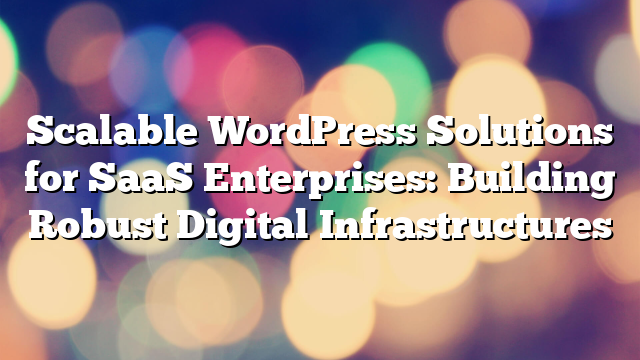WordPress Multisite for Enterprise-Level Content Management
03.12.2024

Managing multiple websites efficiently is a common challenge for enterprises operating at scale. WordPress Multisite offers a powerful solution, allowing businesses to create, manage, and maintain a network of websites from a single WordPress installation. This article explores the capabilities of WordPress Multisite and why it’s an excellent choice for enterprise-level content management.
What is WordPress Multisite?
WordPress Multisite is a feature that enables users to create and manage multiple websites under one WordPress installation. Each site in the network can have its own content, design, and functionality, while sharing the same core files, themes, and plugins. This structure simplifies management, reduces overhead, and provides a unified experience for administrators.
Key Features of WordPress Multisite
1. Centralized Management
Multisite allows administrators to manage all websites in the network from a single dashboard. Tasks such as updates, user roles, and permissions can be streamlined across the network.
2. Shared Resources
All websites in the Multisite network share the same WordPress core, themes, and plugins. This reduces redundancy and ensures consistency across the network.
3. Site Independence
Despite sharing resources, each site in the network operates independently. Administrators can customize content, design, and functionality for individual sites without affecting others.
4. User Management
Multisite offers robust user management capabilities, allowing administrators to assign roles and permissions across the network or specific to individual sites.
5. Domain Mapping
With domain mapping, enterprises can assign unique domains to each site in the network, maintaining a distinct identity for every website while keeping centralized management.
Why Enterprises Should Use WordPress Multisite
1. Efficient Scaling
Enterprises often need to manage multiple websites for different regions, brands, or departments. Multisite provides a scalable solution, allowing businesses to add new sites to the network with minimal effort.
2. Cost Savings
Maintaining a single WordPress installation reduces hosting, maintenance, and update costs. Shared resources and centralized management further contribute to cost efficiency.
3. Simplified Updates
Updates to WordPress core, themes, and plugins can be applied across the entire network from a single dashboard. This ensures consistency and security without manual effort for each site.
4. Consistent Branding
For enterprises managing multiple brands, Multisite allows the use of shared design elements and templates, ensuring consistent branding across all websites.
5. Enhanced Collaboration
Multisite supports multiple administrators and contributors, enabling teams to collaborate on content creation and site management efficiently.
Use Cases for WordPress Multisite
1. Regional Websites
Enterprises with a global presence can create separate sites for each region or language while managing all content centrally. This is particularly useful for multilingual websites.
2. Franchise Networks
Franchise businesses can use Multisite to provide each franchisee with a dedicated website while maintaining control over branding and core functionalities.
3. Educational Institutions
Universities and schools can manage multiple websites for departments, faculties, or campuses under one Multisite network.
4. Corporate Subsidiaries
Corporations managing multiple subsidiaries can ensure consistent branding and simplified administration through a single WordPress Multisite installation.
5. Event Management
Event organizers can create individual websites for different events, using shared resources and centralized management to reduce workload.
Challenges of Using WordPress Multisite
1. Complex Setup
Setting up and configuring Multisite can be challenging, especially for enterprises unfamiliar with the system. Expert guidance may be required to ensure optimal performance.
2. Plugin Compatibility
Not all WordPress plugins are Multisite-compatible. Enterprises need to evaluate and test plugins to avoid functionality issues.
3. Centralized Risks
A single point of failure can affect the entire network. Enterprises must prioritize security, backups, and performance optimization to minimize risks.
4. Resource Demands
Large networks can strain server resources, especially with high traffic. Enterprises should invest in robust hosting solutions to handle the load effectively.
Best Practices for WordPress Multisite
1. Plan Your Network
Define the purpose and structure of your Multisite network before implementation. Identify the number of sites, user roles, and shared resources required.
2. Choose Reliable Hosting
Select a hosting provider that supports Multisite and offers sufficient resources to handle traffic, storage, and performance demands.
3. Prioritize Security
Implement strong security measures, including SSL, regular backups, and access controls, to protect the entire network from threats.
4. Use Compatible Plugins
Test plugins for Multisite compatibility before installing them. Avoid plugins that may cause conflicts or degrade performance.
5. Monitor Performance
Use performance monitoring tools to track load times, server response, and user activity across the network. Optimize resources to maintain high performance.
Conclusion
WordPress Multisite is a powerful solution for enterprises looking to manage multiple websites efficiently. Its centralized management, scalability, and cost-saving features make it an ideal choice for businesses with diverse needs. By following best practices and addressing potential challenges, enterprises can harness the full potential of Multisite to drive their digital strategies forward.
Interested in setting up a WordPress Multisite network for your enterprise? Contact AllWebDev today to learn how we can help you streamline your content management and achieve your business goals.



